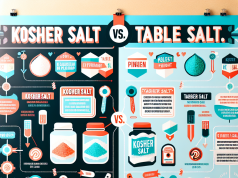Contents
Add a unique twist to your dishes with white pepper
White pepper is a versatile ingredient that can add a distinctive flavor and aroma to your culinary creations. Unlike its black counterpart, white pepper is made from matured, dried and peeled pepper berries. This unique processing method gives white pepper a milder, less pungent taste, making it a perfect choice for those who prefer a more subtle spice in their dishes.
White pepper can be used in a variety of dishes, both savory and sweet. Its subtle heat and floral notes make it a great addition to soups, stews, sauces, marinades, and even desserts. Additionally, it pairs well with vegetables, poultry, seafood, and light meats, enhancing their natural flavors without overpowering them.
When using white pepper, it is important to remember that a little goes a long way. Due to its more delicate flavor profile, a small amount can make a big impact on the overall taste of your dish. It is best to start with a pinch or two, and adjust according to your personal preference.
So why not add a unique twist to your dishes with white pepper? Experiment with this versatile spice and discover new flavor dimensions in your favorite recipes. Whether you want to liven up a classic soup or create a one-of-a-kind dessert, white pepper is sure to bring a touch of sophistication to your culinary ventures.
Add a unique twist to your dishes with white pepper
Why Choose White Pepper?
White pepper is a popular spice known for its unique flavor and culinary versatility. It is derived from the same plant as black pepper but has a milder, slightly fermented taste. The main difference between the two is the way they are processed. White pepper is made from fully ripe pepper berries, which are soaked in water and then have their outer skin removed before drying, while black pepper is made from unripe berries that are dried with the skin intact.
White pepper is widely used in many cuisines around the world and is especially popular in Asian and European cooking. Its subtle heat and earthy flavor can enhance the taste of various dishes, from soups and sauces to marinades and stir-fries.
Health Benefits of White Pepper
In addition to its flavor-enhancing properties, white pepper also offers several health benefits. It contains a compound called piperine, which has been found to have antioxidant and anti-inflammatory effects. These properties may help reduce inflammation, boost digestion, and improve overall gut health.
Furthermore, white pepper is a good source of vitamins, minerals, and dietary fiber. It contains vitamins A, C, and K, as well as essential minerals like calcium, potassium, and manganese. Including white pepper in your dishes not only adds flavor but also contributes to your nutritional intake.
Ways to Use White Pepper in Your Recipes
Now that you know about the benefits of white pepper, let’s explore some creative ways to incorporate it into your recipes:
-
Seasoning Soups and Broths
Add a pinch of white pepper to your favorite soups or broths to give them a subtle heat and enhance the overall flavor. White pepper blends well with ingredients like vegetables, chicken, and seafood, making it a versatile seasoning option.
-
Spicing Up Sauces and Marinades
White pepper can add a unique twist to your sauces and marinades. Whether you’re making a creamy pasta sauce or marinating meat for grilling, a dash of white pepper can elevate the taste and make your dish more interesting.
-
Enhancing Stir-Fries and Sautéed Dishes
If you enjoy stir-fried or sautéed dishes, white pepper can be a game-changer. Its mild heat and complex flavor complement vegetables, meats, and seafood, creating a delightful balance of taste.
Conclusion
Adding white pepper to your culinary endeavors can bring a unique twist to your dishes. Its subtle heat and distinct flavor make it a versatile spice suitable for various recipes. Not only does it enhance the taste, but it also offers several health benefits. So, next time you’re looking to add some extra flavor to your cooking, don’t forget to reach for the white pepper!
For more interesting spice-related topics, check out our related blog post on exploring different spices from around the world.
FAQs – Add a unique twist to your dishes with white pepper
What is white pepper?
White pepper is a spice derived from the dried seeds of the pepper plant, Piper nigrum. It is essentially the same as black pepper but with the outer layer removed, resulting in a milder and slightly different flavor.
How is white pepper used in cooking?
White pepper is commonly used in various culinary applications. It can be used to season soups, stews, sauces, marinades, and various meat and vegetable dishes. It adds a subtle heat and brings a unique flavor profile to the dishes.
What are the benefits of using white pepper?
White pepper offers several benefits. It is known to aid digestion, stimulate appetite, and promote gut health. Additionally, it contains various antioxidants and anti-inflammatory properties. Its flavor can enhance the taste of your dishes and provide a distinct twist.
Can white pepper be substituted with black pepper?
While white and black pepper come from the same plant, they have notable taste differences. White pepper has a slightly different flavor profile and is milder compared to black pepper. However, if you don’t have white pepper on hand, black pepper can be used as a substitute, although it may alter the intended taste of the dish.
Are there any precautions to consider when using white pepper?
White pepper is generally safe for consumption, but some individuals may be sensitive or allergic to it. It is recommended to use it in moderation, especially if you are trying it for the first time. As with any spice, excessive consumption may cause stomach discomfort or irritation.
About White Pepper
What is White Pepper?
White pepper is a variety of pepper widely known for its distinct flavor and culinary uses. It is derived from the same plant as black pepper (Piper nigrum), but the difference lies in the way they are processed. White pepper is obtained by removing the outer layer of ripened black pepper berries, then drying and grinding the inner seed.
Flavor Profile and Culinary Uses
White pepper offers a milder and less pungent flavor compared to black pepper. It has a slightly earthy and spicy taste, along with subtle floral notes. Due to its unique flavor profile, white pepper is commonly used in specific dishes where its taste can shine.
Here are some popular culinary uses of white pepper:
- White pepper is frequently incorporated into light-colored soups, sauces, and creamy dishes where the aesthetics of black specks may not be desirable.
- It is a key ingredient in classic dishes like white pepper crab, where the delicate taste of the pepper complements the sweet and succulent meat.
- White pepper is often used to season poultry, fish, vegetables, and stir-fries, providing a subtle heat without overpowering the dish.
- In certain cuisines, such as Thai and Chinese, white pepper is a common seasoning in various meat and seafood dishes.
Health Benefits
Aside from its culinary uses, white pepper also offers some potential health benefits. It contains certain compounds that may enhance digestion, contribute to antioxidant activity, and possess antimicrobial properties. However, it’s important to note that further scientific research is necessary to fully understand its effects on human health.
If you want to learn more about white pepper, you can visit the White Pepper Wikipedia page.
Benefits of White Pepper:
-
Enhances Flavor:
White pepper adds a distinct and slightly pungent taste to your dishes.
-
Versatility:
It can be used in various recipes including soups, sauces, marinades, and stir-fries.
-
Health Benefits:
White pepper may aid digestion, improve appetite, and provide anti-inflammatory properties.
-
Subtle Appearance:
Unlike black pepper, white pepper blends well with light-colored dishes without leaving dark specks.
-
Prolonged Shelf Life:
Whole white peppercorns can last longer than ground pepper, retaining its freshness.








































